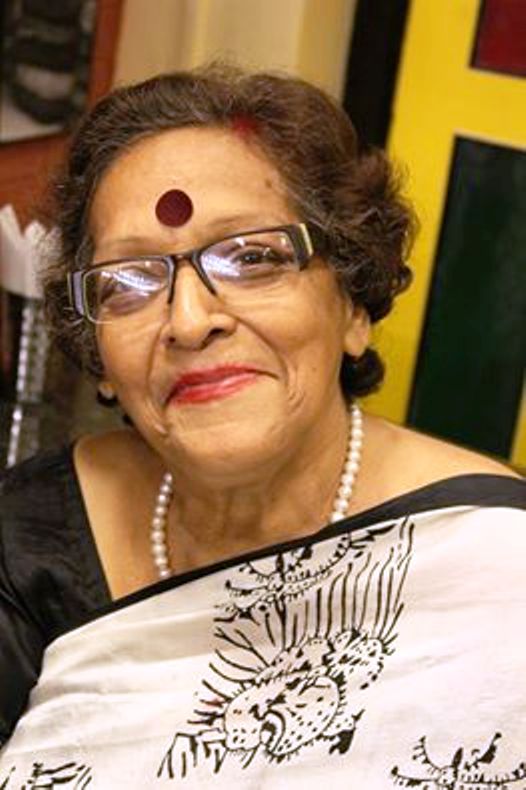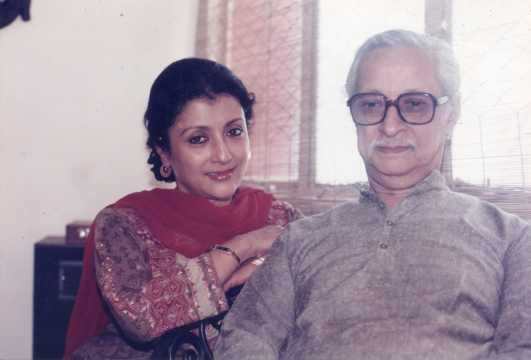The director, scholar, author and occasional music composer will always be remembered as a titan of cinema journalism.
Chidananda Das Gupta, film critic par excellence – Centenary special
Kolkata - 20 Nov 2021 12:28 IST
Updated : 17:12 IST


Shoma A Chatterji
I first met the great Chidananda Das Gupta at my first Filmotsav at Hyderabad in 1986. I was awe-struck by his very presence. He was among the few film critics whose name will remain archived in the history of film journalism in India. Among the others, one might mention Iqbal Masud, Baburao Patel, BK Karanjia, TN Ramachandran and Amita Malik. Das Gupta was the lone ranger in West Bengal and remains so to this day.
But my awe was soon replaced with surprise and amazement at his completely rooted personality, warmth and friendliness. Das Gupta did not once treat me like the wet-behind-the-ears journalist that I was, still struggling to find space in the ever-growing world of film journalism. We sat beside each other to watch the Japanese film making the first show within International cinema. I did not know where to look because the film was overflowing with graphic scenes of sex between a doddering old painter and a teenage girl brought in by his wife to keep his 'creative juices' flowing. But Chidu Uncle set me at ease and said I had better get used to this stuff because uncensored films were one of the attractions of an international film festival.
We spent the ten days of the festival watching films together. For me, it was a wonderful learning experience. He taught me a few things about writing per se and about writing on cinema.
I discovered that his depth of knowledge about cinema, both Indian and international, was astounding though he began his professional career with SPAN, not as a journalist but an administrative head looking after public relations. His interest in films came about when, in 1947, he pioneered the film society movement with like-minded friends Satyajit Ray and Harisadhan Dasgupta.

He once reminisced, "A comment from Cyril Connolly, editor of Horizon, who said, 'Calcutta is a city which has no film society' set off the trigger, more because Bombay had already laid the foundation for two film societies, one in 1937 and another in 1942. Neither of these evolved into a movement. Nor did they bring about changes in Indian cinema. We decided to change all this. With 50 members at a membership fee of Rs5 a month and Prasanta Mahalanobis as our first president, the membership looked like a veritable who’s who of the Calcutta intelligentsia.”
Das Gupta suggested the formation of a film federation and, along with six others, met freedom fighter, author and parliamentarian Krishna Kripalani in 1959. In 1960, the federation began to function.
He added, “Manik [Ray] egged me on to see good films and would sometimes take me to see a film for the second time. I was personal assistant to Prasanta Mahalanobis, the economics scholar at the Indian Statistical Institute who taught English literature in the evenings at City College.
"The turning point came in 1946 when I attacked an essay penned by noted author Buddhadev Bose in Parichay. The impressed editors, Hiren Mukherjee and Niren Roy, asked me to write for them. In 1947, Satyajit Ray, Harisadhan Dasgupta, fresh from UCLA, and I founded the Calcutta Film Society."
The first lesson I was taught by Das Gupta was how to contextualize a film or filmmaker while writing about them. This interaction happened when we spent ten days together at the Mannheim-Heidelberg Film Festival in Germany some time in the 1990s. He was a member of the FIPRESCI jury and I was a press delegate. We lived in the same hotel in rooms next to each other and managed to squeeze lunch together.
What did he mean by “contextualizing”? He explained that a serious critic needs to research the background of the filmmaker and, in case of a review, one preferably needed to know about the other films made by the filmmaker concerned. Because the way a director was shaped, his social backdrop, went on to mould his creativity as a filmmaker.
Modern film critics lack a consistent ideological positioning, according to Chidu-da. “Some of them lack aesthetic sensibility. Some mistake aesthetics for sensibility,” he wrote in one among a hundred other papers titled Black Hole of Indian Film Criticism.

A few years before his death, Chidu-da was persuaded to speak at a panel discussion at a book release function at the British Council, Calcutta. The book was Shyam Benegal by Sangeeta Dutta. He fascinated the select audience with his amazing command of the socio-political backdrop against which Benegal made the transition from the synthetic and technically sophisticated world of ad films to feature films with Ankur (1974), tracing Benegal’s evolution over time till his last-released film Zubeidaa (2001).
Then 83, Chidu-da did not keep too well and often had to lean on a walking stick. But that did not take away from him his soft-spoken, completely casual way of putting erudite things across for the understanding of the common man. He enlarged the canvas of cinema to include the world and in so doing raised cinema to a level that blends cerebral experience with aesthetic enjoyment defining ideal entertainment.
Das Gupta was not just a film critic, he was a film scholar, an author, a director and even composed the music for a few films. But he wore none of these roles on his sleeve.
He made history with the Lifetime Achievement award bestowed on him for Best Writing at the Sixth Osian’s Cinefan Festival of Asian Cinema in 2004. This was the first-ever Lifetime Achievement award to have been conferred on a film critic and scholar.
“I am getting this award at a time when film criticism is almost dying out in India," he said in response. "We spent our lives teaching people the value and worth of cinema. When we first asked for the government for help form the first film society, the official at the ministry said, 'Film society, what's that?’ Thankfully, lots of things have changed since then.”

He directed Bilet Pherat (1972) and Amodini (1984), two full-length feature films, without giving up writing books or critiquing films. Amodini won a couple of National awards. He has presented in-depth papers on cinema at national and international seminars, chairing quite a few of them, moderating others. Interestingly, his wife won the National award for Best Costume Design for the film, which makes them perhaps the only film family in Bengali cinema where four members have won the National award — he won two while his wife, his eldest daughter Aparna Sen and granddaughter Konkona Sensharma are all National awardees carrying the legacy of excellence through three generations.
Recalling his early life, Das Gupta said, “I was born in Shillong [then the capital of Assam, now the capital of Meghalaya] in 1921 to staunchly Brahmo parents who were dead against cinema of any kind. While in college, I was externed from Patna for my involvement in the 1942 [Quit India] movement. I then came to Kolkata to do my post-graduation. An early marriage in 1944 my parents were opposed to, though my wife Supriya is also from a Brahmo family, forced me to take up a lecturer’s job at St Columba’s College in Hazaribagh [then in Bihar and now in Jharkhand] at a salary of Rs100. At the time, it was not a modest sum.”

Among the books he has authored are The Cinema of Satyajit Ray (1980), Talking About Films (1981), Satyajit Ray: An Anthology of Statements on Ray and by Ray, edited by Chidananda Das Gupta (1981), Unpopular Cinema, The Painted Face: Studies in India’s Popular Cinema (1991), and Seeing Is Believing: Selected Writings on Cinema (2008). All have run into several editions.
He also wrote prolifically for international publications. He won the Best Film Critic award at the National Awards many years ago. He wrote the musical score for his daughter Aparna Sen’s film Sati (1989). He also received a fellowship to make a documentary on Prince Dwarakanath Tagore, grandfather of Rabindranath Tagore.
He directed a documentary on Mrinal Sen on the grounds that the filmmaker's contribution to Indian cinema had neither been duly recognized nor properly honoured. “Praises, awards, international acclaim showered on Satyajit Ray and Ritwik Ghatak have effectively marginalized Mrinal’s contribution. I consider this unfair and wish this film will shed light on his rich and unforgettable contribution to cinema,” he said, justifying his move. Sadly, the film has never been screened publicly.
When I requested him to go through the first chapter of a very heavy book on Indian cinema I was writing, he went through it with a tooth-comb and pointedly told me to throw it all out and write everything again. I was devastated. He said, “Your writing lacks focus of any kind. You need to do this all over again and the focus will come to you as you begin to rewrite.”
I did what he said and sat down to begin all over again. The results turned out to be surprisingly different from what I had written before. He suggested I go on minus guidance because I did not need any now. That was my first serious work on the portrayal of women in Indian cinema.
Das Gupta refused to write a foreword to my book on Aparna Sen because he said it would be unethical for him to do the foreword to a book on his own daughter’s cinema. But he graciously accepted the invitation to the book launch at a book store in Kolkata where both his daughter and granddaughter Konkona, who was yet to step into films, were present.
International film festivals he had not visited, either as a delegate or a jury member, could be ticked off the fingers of one hand. He did a much-discussed translation of the works of noted poet Jibananda Das and wrote a critical analysis of Peter Brooks’ The Mahabharata.
At the end of it all, when asked which of his creations he would choose as his best, the response was unhesitating. “Aparna Sen,” he would say and we would leave it at that.
Related topics
Indian cinema



